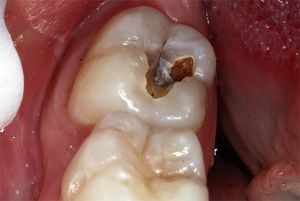 Teeth of wisdom( Dens Serotinus - lat.) Or third molars are the latest in the dentition and eighth in the general classification of teeth, located deep in the oral cavity on each side.
Teeth of wisdom( Dens Serotinus - lat.) Or third molars are the latest in the dentition and eighth in the general classification of teeth, located deep in the oral cavity on each side.
The most convenient numbering system is the international system of Viola, according to it wisdom teeth are designated as 18, 28, 38, 48.
They appear already in the adult state, at the age of 18-27 years, sometimes much later, there are cases when eights do not eruptat all.
The structure and size do not differ from the first and second molars, except that the root can be curved.
Erection of eights is very often associated with pain. Due to the fact that there is little room left in the dentition, he has to shift the standing teeth next to him.
Since at the age when the "wise man" starts to grow, bone tissue is already formed, there are difficulties with its proper arrangement. Often it grows at an inclination or even horizontally, can sprout into the cheek or gum.
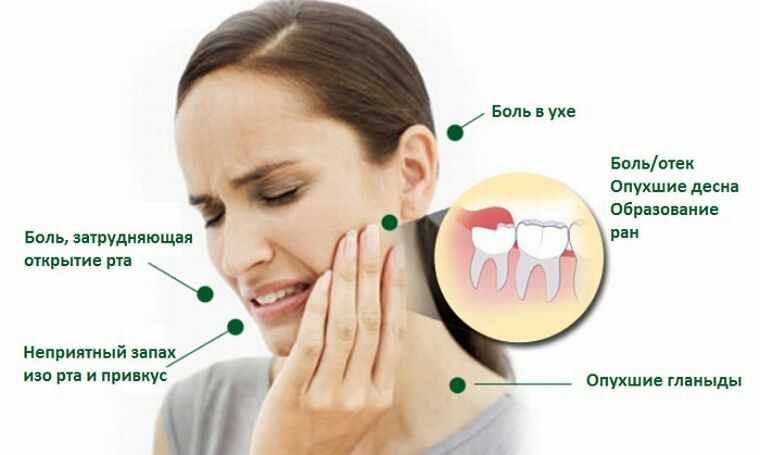
When the "eight" climbs the whole face and head. ..
Contents
- Hole in wisdom tooth is not uncommon, but also does not matter
- Varieties of carious areas
- About complexity of treatment of "eight"
- Can not be treated
- Cost of treatment
Hole in toothwisdom is not uncommon, but also does not matter
Caries is more often a chronic disease characterized by the destruction of hard tooth tissue, under the influence of microorganisms. An important role in the development of dental caries is played by dental plaque - a viscous film consisting of bacteria, products of their vital activity, food residues.
The third molar, though later cut through other teeth, can be destroyed more quickly than others. This occurs as a result of poor-quality cleaning due to location peculiarities, it can also be partially covered with gum, have a so-called hood, in which food remains very quickly accumulated. Therefore, dental plaque is formed on it faster than on other teeth. 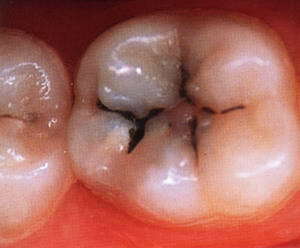
The formation of the plaque begins with the appearance of a film consisting of some components of saliva, then the bacilli join, which multiply, release the decay products.
Mature plaque is not washed off by saliva, nor by rinsing, as it fits tightly to the enamel. In the presence of a sweet environment, organic acids are formed, the process of demineralization of hard tissues begins.
Another reason for the appearance of caries on the figure eight is its long and partial eruption, becausemicroorganisms penetrate the gums, in a closed environment begin to multiply, and often the third molar grows already carious.
Varieties of carious areas of
Caries of third molars is classified according to the same system as the caries of the remaining teeth:
- in the depth of the process - caries in the stain, surface, medium, deep;
- on the anatomical location of - caries of enamel, dentin, cement;
- for localization - fissure, interdental, cervical.
The difference of tooth decay on the wisdom tooth is that the disease is more often asymptomatic, and because of its inaccessibility of the "eight" for a long time can be ignored and found only in the deep stage of destruction.
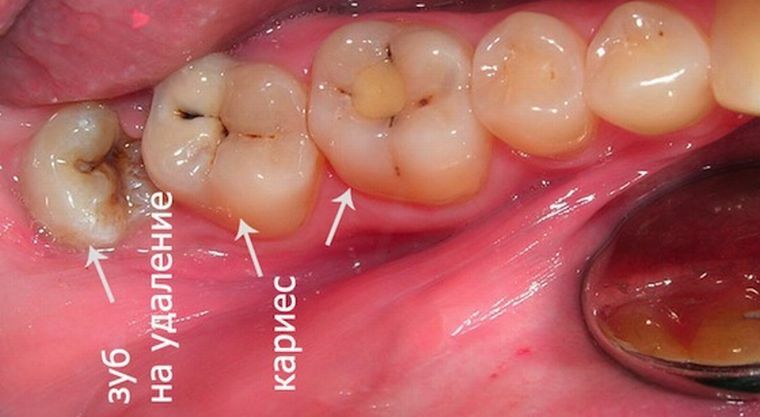
In the picture, the surface caries "7-ki" and the deep wisdom tooth - the second one can not be saved
The complexity of treating the "eights"
The treatment process is complicated by the fact that caries of the 8 tooth is diagnosed already in the advanced stage, and its location allows for a large volume of therapeuticprocedures.
First you need to drill the affected tissue, treat it with a disinfectant solution. If the carious process is only in the cavity, then it is necessary to apply a healing pad and seal, and then restore the anatomical shape of the crown.
If the carious process has spread to the root, then the treatment becomes even more difficult, since only an experienced specialist can qualitatively pass through the channels in the crimped roots of the wisdom tooth. During the entire treatment period, the patient must sit with his mouth wide open to facilitate access to the doctor.
Can not be treated
The decision to remove the third molar dentists take much more often than to extract other teeth. The wisdom teeth are treated for caries only if the carious process is in the surface stage, and the molar is cut completely and evenly in the arc, that is, without inclinations in one or another plane.
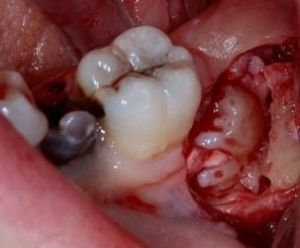 If he protrudes from the gums only partially and has been in this condition for several years, growing on the cheek or resting on the next sevens, causing pain, the unambiguous decision will be removal.
If he protrudes from the gums only partially and has been in this condition for several years, growing on the cheek or resting on the next sevens, causing pain, the unambiguous decision will be removal.
Treatment will be effective only if there is no gingiva hood, because its presence provokes the appearance of microorganisms and the development of secondary caries.
Trying to save a sick tooth is also possible in the case of an antagonist - the opposite eight.
Given the complexity of location and treatment, the decision to remove the problem eight is the best way out of the situation.
Advantages of extraction:
- the remote "wise man" will not move his neighbors due to lack of space for him, and therefore will not cause crowding of teeth;
- together with the removal of the affected tooth is removed and the focus of infection;
- rescue of the patient from excruciating pains;
- does not need to pay for re-treatment.
Cons:
- in case there are many missing teeth in the oral cavity, there will be no support for prosthetics;
- complications are possible, as in any surgical operation.
Advantages of treatment:
- in case of presence of antagonist, both teeth will be involved in the process of grinding food;
- retains support for possible prosthetics.
And the cons of this solution:
- the risk of developing secondary caries;
- spread of infection to other teeth;
- treatment in the case of each relapse requires the investment of additional funds.
The cost of treatment
Treatment of the third molar is twice as expensive as an ordinary tooth, and will be from 2000 to 5000 rubles, depending on the complexity of the situation. Extraction will cost 1800 rubles and more.
